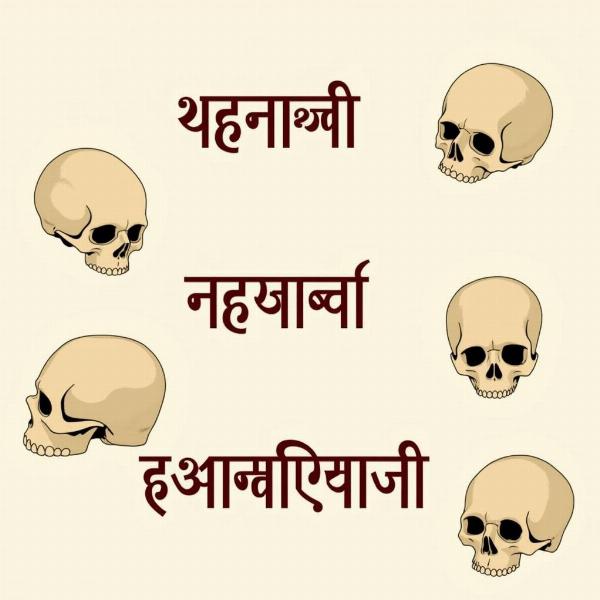Understanding the meaning of “skull” in Hindi involves more than just a simple translation. It delves into cultural nuances, religious symbolism, and a range of related terminology. This exploration encompasses not only the literal meaning but also the rich tapestry of associations the skull holds within Indian culture. What does “skull” mean in Hindi, and how does its significance resonate within various contexts? Let’s uncover the layers of meaning behind this potent symbol.
The Hindi Word for Skull: “Khopdi” and Beyond
The most common Hindi word for skull is “खोपड़ी” (khopdi). However, depending on the context, other terms like “कपाल” (kapal) and “शिरःकपाल” (shirshkapal) can also be used. While “khopdi” refers specifically to the bony structure of the head, “kapal” has a broader meaning, often encompassing the forehead or the entire head. “Shirshkapal” is a more formal and less frequently used term.  Hindi words for skull
Hindi words for skull
The choice of word depends heavily on the context. In everyday conversation, “khopdi” is the most natural choice. In religious or literary contexts, “kapal” might be preferred, especially when referencing ancient texts or scriptures. The subtle differences in these terms add depth and nuance to the meaning of “skull” in Hindi.
Skull Symbolism in Hinduism
The skull holds a powerful symbolic meaning in Hinduism, particularly within Shaivism and Tantric traditions. Lord Shiva, one of the principal deities of Hinduism, is often depicted wearing a garland of skulls (mundmala). This symbolizes the cycle of birth, death, and rebirth, emphasizing the transient nature of life. The skull represents the impermanence of the physical body and the liberation of the soul.
Moreover, the skull is associated with wisdom and detachment. By embracing the symbol of death, one is thought to transcend the fear of mortality and achieve a higher level of spiritual understanding. This association with Lord Shiva further reinforces the skull’s connection to spiritual power and enlightenment.
Skull in Indian Literature and Folklore
The skull appears frequently in Indian literature and folklore, often representing mortality, fear, and the supernatural. In some stories, skulls are used in rituals or associated with black magic. In others, they serve as reminders of the fragility of life. The skull’s presence in these narratives often adds a layer of mystery and intrigue.
For example, the “vetala” (a type of ghost or reanimated corpse) in the famous “Vetala Panchavimshati” is often depicted clinging to a skull. This connection further reinforces the association between the skull and the world beyond the living.
Skull in Medical and Anatomical Contexts
Outside of religious and symbolic contexts, “khopdi” maintains its straightforward anatomical meaning. Medical professionals and scientists use the term to refer to the human skull, discussing its structure, function, and related medical conditions.
What is the meaning of the skull and crossbones symbol?
While the skull itself holds various meanings, the skull and crossbones symbol is generally understood as a warning of danger, particularly relating to poison or death. Although not as prevalent in traditional Indian imagery, this symbol has become globally recognized through its use in warning labels and popular culture.
Conclusion: More Than Just Bone
The meaning of “skull” in Hindi extends beyond a simple anatomical definition. From “khopdi” to “kapal,” the terminology itself reflects the nuanced understanding of this potent symbol. Its significance within Hinduism, its presence in literature and folklore, and its clinical usage in medicine all contribute to a rich tapestry of meaning. Understanding the cultural and symbolic weight of the skull provides a deeper appreciation for its multifaceted role in Indian thought and tradition.
FAQs
-
What is the most common Hindi word for skull? The most common word is “khopdi” (खोपड़ी).
-
Why does Lord Shiva wear a garland of skulls? The mundmala symbolizes the cycle of birth, death, and rebirth, and Lord Shiva’s mastery over it.
-
Is the skull always seen as negative in Indian culture? No, while sometimes associated with fear or death, it also represents wisdom and spiritual liberation.
-
What is the medical term for skull in Hindi? “Khopdi” is also used in medical contexts. Other terms like “kapal” and “shirshkapal” might be used in more formal or specialized settings.
-
What does the skull and crossbones symbolize? It generally represents danger or poison.
-
Where can I learn more about Hindi words and their meanings? You can explore resources like dictionaries and online language learning platforms. Meaning-Hindi.in offers specialized translation services for various fields.
-
What is the significance of the skull in Tantric traditions? The skull holds deep symbolic meaning in Tantra, often representing spiritual power and transformation.
Meaning-Hindi.in is your trusted partner for all your Hindi translation needs. We specialize in a wide range of translation services, including business and commercial documents, legal and certified translations, technical manuals, website localization, and educational materials. Our expertise in Hindi language and culture ensures accurate and culturally sensitive translations. Contact us today at [email protected] or call us at +91 11-4502-7584 to discuss your translation requirements. Let Meaning-Hindi.in help you bridge the language gap.